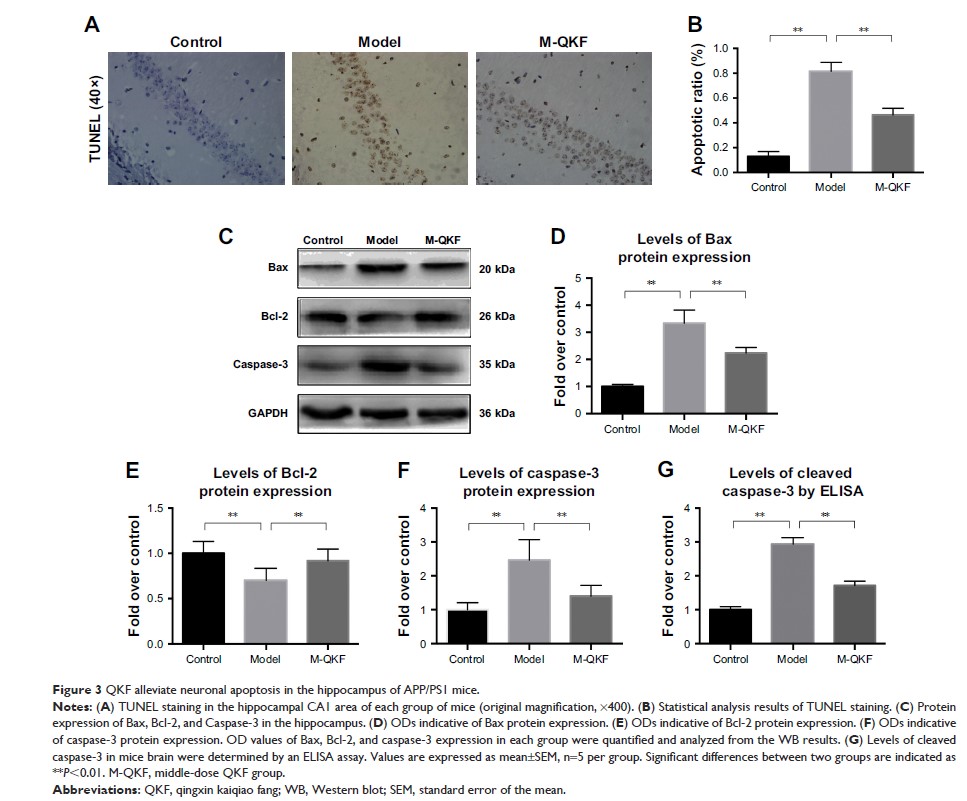9 0 6 7 6
论文已发表
注册即可获取德孚的最新动态
IF 收录期刊
- 2.6 Breast Cancer (Dove Med Press)
- 3.9 Clin Epidemiol
- 3.3 Cancer Manag Res
- 3.9 Infect Drug Resist
- 3.6 Clin Interv Aging
- 4.8 Drug Des Dev Ther
- 2.8 Int J Chronic Obstr
- 8.0 Int J Nanomed
- 2.3 Int J Women's Health
- 3.2 Neuropsych Dis Treat
- 4.0 OncoTargets Ther
- 2.2 Patient Prefer Adher
- 2.8 Ther Clin Risk Manag
- 2.7 J Pain Res
- 3.3 Diabet Metab Synd Ob
- 4.3 Psychol Res Behav Ma
- 3.4 Nat Sci Sleep
- 1.9 Pharmgenomics Pers Med
- 3.5 Risk Manag Healthc Policy
- 4.5 J Inflamm Res
- 2.3 Int J Gen Med
- 4.1 J Hepatocell Carcinoma
- 3.2 J Asthma Allergy
- 2.3 Clin Cosmet Investig Dermatol
- 3.3 J Multidiscip Healthc

清心开窍方经由 MAPK 通路在 APP/PS1 双转基因小鼠中改善记忆障碍并遏制细胞凋亡
Authors Gao SY, Lin J, Wang T, Shen Y, Li Y, Yang W, Zhou K, Hu H
Received 24 September 2018
Accepted for publication 18 December 2018
Published 23 January 2019 Volume 2019:13 Pages 459—475
DOI https://doi.org/10.2147/DDDT.S188505
Checked for plagiarism Yes
Review by Single-blind
Peer reviewers approved by Dr Colin Mak
Peer reviewer comments 2
Editor who approved publication: Professor Jianbo Sun
Background: Qingxin
kaiqiao fang (QKF) has been found to treat Alzheimer’s disease (AD) through
apoptosis inhibition. The mitogen-activated protein kinase (MAPK) pathway is
closely related to apoptosis in the course of AD. This study aimed to
investigate whether QKF-induced apoptosis depression is achieved through MAPK
pathway.
Materials and methods: C57BL/6 J
and APP/PS1 mice were used as control and model groups. APP/PS1 mice were
treated with different dosages of QKF (4.75, 9.5, and 19 g·kg-1·d-1·ig,
respectively) for 12 weeks as L-QKF, M-QKF, and H-QKF groups. The M-QKF-treated
APP/PS1 mice were administrated with 2 µg/kg of U46619 and saline, intra
ventricular ventricle injection, as M-QKF+U46619 and M-QKF+saline groups and
were injected with PD98059 0.3 mg/kg and the same volume of dimethyl sulfoxide
(DMSO), intravenous, as M-QKF+PD98059 and M-QKF+DMSO groups. After 12 weeks
treatment, Morris water maze was performed for behavior study. Pathological
degeneration was examined by H&E staining, Nissl staining, and transmission
electron microscope observation of hippocampus; immunohistochemistry and
Western blot (WB) were tested for amyloid β (Aβ) expression. Apoptosis was
measured through TUNEL assay; Bax, Bcl-2, and caspase-3 expression through WB;
and cleaved caspase-3 expression through ELISA. MAPK pathway was detected via
WB for the expressions of ERK1/2, JNK, and p38 MAPK and their phosphorylation
patterns.
Results: QKF
improved the learning and memory capability, as well as inhibited neuronal apoptosis
and then reduced the pathological degeneration of APP/PS1 mice. M-QKF reduced
neuron apoptosis by inhibiting p38 MAPK and activating ERK1/2 but had no
significant effect on JNK.
Conclusion: QKF,
especially at the middle dose, alleviated the learning and memory impairment
and played an antiapoptotic role in AD through MAPK pathways.
Keywords: Qingxin
kaiqiao, Alzheimer’s disease, apoptosis, APP, PS1 mice, MAPK
